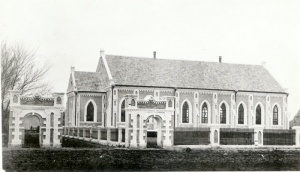Schönsee Mennonite Church (Molotschna Mennonite Settlement, Zaporizhia Oblast, Ukraine)

Scan courtesy Mennonite Church USA Archives-Elkhart X-31.1, Box 17/13
Schönsee Mennonite Church, Molotschna settlement, South Russia, was until 1842 a part of the large Lichtenau congregation and from then until the beginning of the century a part of the Margenau congregation. In 1903 it became independent under its own elder, Heinrich Peters. The greater part of the inhabitants of the following villages belonged to the Schönsee congregation: Fürstenau, Fabrikerwiese, Schönsee, Liebenau, Wernersdorf, about one quarter of Hamberg and Klippenfeld, and some of the large estates lying at some distance from the Molotschna in a southeasterly direction, altogether about 1,500 souls. Almost without exception they were farmers whose forefathers had come from the Danzig district of Prussia at the beginning of the 19th century. Sunday school was introduced only after the revolution, when religious instruction was prohibited at the day schools.
The congregation had a choir but there was no instrument to accompany the singing. The first church building was erected in 1831 behind the orchards of the village of Schönsee, all of wood in the old Prussian church style. Later it was surrounded by mighty trees and, although simple and small, had a beauty of its own. In 1909 a new church was built at the eastern end of the village of much larger size and in a more modern style, one of the largest and most beautiful Mennonite churches in Russia.
Some of the more prominent ministers of the congregation were Elder Heinrich Peters, who served his congregation with great devotion as minister from 1885 and as elder from 1903 until his death in 1921 during the great typhoid epidemic; Jacob Renpenning (1885-1922), owner of a large agricultural machinery factory in the village of Fabrikerwiese, who was a good speaker and earnest Christian; and Bernhard Wiens 1903-1930, who besides being an outstanding minister for 19 years, served the village of Schönsee as a very efficient schoolteacher. But the most important minister the congregation ever had was Alexander Ediger, who was called to the ministry at an hour (1922) when the storms of the Russian Revolution and the civil war swept the country. He was a man of exceptional intellectual and spiritual power, whose influence extended far beyond the boundaries of the Molotschna. In 1931 Elder Ediger was imprisoned at Melitopol and later banished to Murmansk. Johann Görz, a young minister, continued to conduct services for a while in private homes until he also was banished.
The church building was first turned into a granary and then into a communist club. A large stage was erected at the front with a curtain picturing the goddess of beauty. Between the windows on the walls life-sized pictures of Lenin, Stalin, and other leaders of the revolution were placed. During the German occupation the building again for a short time was used as a church.
In 2013, the former Mennonite church was refurbished as a Ukrainian Greek Catholic church.
Bibliography
Friesen, Peter M. Die Alt-Evangelische Mennonitische Brüderschaft in Russland (1789-1910) im Rahmen der mennonitischen Gesamtgeschichte. Halbstadt: Verlagsgesellschaft "Raduga", 1911.
| Author(s) | Heinrich Goerz |
|---|---|
| Date Published | 2015 |
Cite This Article
MLA style
Goerz, Heinrich. "Schönsee Mennonite Church (Molotschna Mennonite Settlement, Zaporizhia Oblast, Ukraine)." Global Anabaptist Mennonite Encyclopedia Online. 2015. Web. 29 Mar 2025. https://gameo.org/index.php?title=Sch%C3%B6nsee_Mennonite_Church_(Molotschna_Mennonite_Settlement,_Zaporizhia_Oblast,_Ukraine)&oldid=162986.
APA style
Goerz, Heinrich. (2015). Schönsee Mennonite Church (Molotschna Mennonite Settlement, Zaporizhia Oblast, Ukraine). Global Anabaptist Mennonite Encyclopedia Online. Retrieved 29 March 2025, from https://gameo.org/index.php?title=Sch%C3%B6nsee_Mennonite_Church_(Molotschna_Mennonite_Settlement,_Zaporizhia_Oblast,_Ukraine)&oldid=162986.
Adapted by permission of Herald Press, Harrisonburg, Virginia, from Mennonite Encyclopedia, Vol. 4, p. 476. All rights reserved.
©1996-2025 by the Global Anabaptist Mennonite Encyclopedia Online. All rights reserved.

